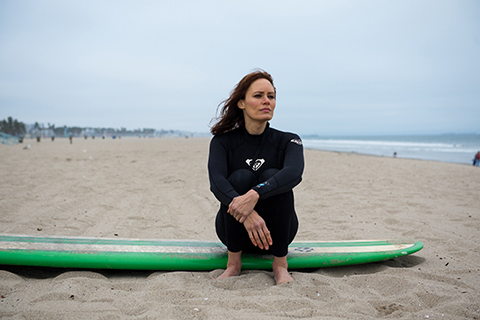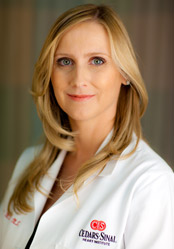The Why Behind Heart Disease and Young Women
Young, athletic women who think they can outrun heart disease need to think again. While the condition is declining in nearly every other demographic, women aged 35–44 are experiencing an alarming increase in heart-related illness. Chrisandra Shufelt, MD, wants to know why.

Emily Swallow's highly active lifestyle and stressful career could put her at risk for future heart problems.
"Events must be occurring in a woman’s body in her 20s and 30s that impact her heart health in midlife and beyond," said Shufelt, associate director of the Barbra Streisand Women’s Heart Center at the Smidt Heart Institute and director of its Women’s Hormone and Menopause Program.
Shufelt has a robust hypothesis as to what those events might be. She describes a population of women who unwittingly drive themselves into a state of severely low estrogen through over-exercising, undereating, stress, or a combination of all three.
That estrogen deficiency at a young age is what may lead to heart damage over time: Estrogen is believed to have a positive effect on the inner layer of artery walls, helping to keep blood vessels flexible and increasing blood flow to the heart. This is why risk factors for heart disease increase after menopause when estrogen levels decline.
With funding from the Louis B. Mayer Foundation, Shufelt previously conducted a pilot study of 18 young women. She found that those who stopped menstruating due to low estrogen were beginning to develop dysfunction in the lining of the heart’s blood vessels. Based on that preliminary work, she was awarded a five-year grant by the National Institutes of Health in 2017.
Shufelt’s study is looking at a common cause of low estrogen in young women: functional hypothalamic amenorrhea, the absence of three or more menstrual cycles in a row. For such women, the signal in the brain that controls their menstrual cycle and tells the ovary to release an egg each month shuts down, resulting in low estrogen levels. This condition affects an estimated 1.6 million women aged 18–44 in the U.S. and some 17.4 million women worldwide.

Chrisandra Shufelt, MD
"A missed period is a signal from the body, but unless these women are trying to get pregnant, they don’t think much of it," Shufelt said. "I coined the term `the walking well' to describe them because they look very healthy and don’t consider themselves ill, as they are young and active."
Previous research has shown that extraordinarily active women, such as college athletes, are susceptible to bone loss and fractures due to low estrogen. Until now, however, little has been known about low estrogen’s impact on younger, active women’s heart health.
Shufelt is recruiting three groups of women for her study: those with functional hypothalamic amenorrhea and no periods for at least three months; those who have regular monthly menstrual cycles; and those who have entered menopause within the past three years. Women in the study range in age from their 20s to their 50s.
Fit, driven women of childbearing age are rarely the target of cardiac research. In an era when obesity is epidemic, heart disease is considered a man’s problem, and the zeitgeist suggests that the ideal woman should emulate Sheryl Sandberg at the office and Wonder Woman at the gym, physicians often dismiss otherwise healthy women with irregular menstrual cycles as having nothing to worry about. But not Shufelt.
"We need to get to the bottom of why younger women are developing a potentially deadly condition at higher and higher rates," she said.
Actress Emily Swallow has done her time as a "walking well" woman. Throughout her 30s, she was a red-eye regular, flying from her current home in Los Angeles to her former one in New York City for theatrical work and to visit her fiancé. After her start playing nameless television characters such as "Security Chief" and "Nurse,": she found success on Broadway and in hit TV shows like Supernatural, How to Get Away with Murder, and The Mentalist.
Her professional schedule was relentless, and her menstrual cycle was inconsistent, with many missed periods. Still, Swallow had no reason to connect the phenomenon to the stress experienced by many working actors.
"Everyone in my business feeds into crises," she said. "In the early years of my career, I embraced that. It’s easy to feel like, if the work didn’t all get done yesterday, we are all going to die."
Plus, acting offers the anguish of the intermittent reward. Landing work is unpredictable, but "when you get one of those great jobs, it checks all the boxes for your emotional fulfillment," Swallow said. "I was counting on that source of satisfaction, and it was definitely stressful because so much of my worth was wrapped up in it."
She sweated out her stress in high-intensity boot-camp fitness classes and surfed the waves of the Pacific Ocean that surge just beyond her Venice apartment. She also packed volunteer work into her days, running the Ocean Friendly Restaurants program for the beach-forward nonprofit Surfrider Foundation.
"I grew up near the beach in Florida, but then I saw this coastline, and it’s an entirely different experience. I love it, and I want to protect it," Swallow said.
The program she manages helps restaurants produce less of the waste that ends up in the ocean, like plastic straws, cups, and to-go containers.
Given her busy schedule, Swallow didn’t mind an irregular menstrual cycle while in her late 20s. "I thought it was awesome that I didn’t get a period," she said. "It’s so much more convenient!"
Certainly, her diet gives no cause for worry, as she eats a wide variety of healthy foods. Nor does she smoke or have high blood pressure. Still, as the missed periods mounted up, "I recognized it could be a health concern," she said.
Swallow visited numerous physicians, including multiple gynecologists and an endocrinologist. Some were baffled by her condition. Others seemed unconcerned.
"I would talk to my OB-GYN and he would just say, `I don’t know, that’s weird,'" she said. "I got tired of going to doctors and answering the same questions over and over. Nobody knew what to do about it."
Swallow joined Shufelt's clinical trial hoping to learn more about her condition. When the two met, Swallow discovered she has functional hypothalamic amenorrhea and that many other women have it, too.
"That was the first time I’d ever talked to someone who seemed to absorb the information I was giving her and respond to it with, `Yes, that happens,'" Swallow said.
Shufelt identified stress and over exercise as probable causes of Swallow’s low-estrogen state. Those boot camps, cross-country flights, and career pressures had combined to exact a toll.
Cedars-Sinai investigators believe it is time to look beyond the group that many physicians consider "normal" heart disease sufferers: men.
"I think it speaks volumes that the NIH is sponsoring this study. It’s time to look outside the box of traditional heart risk factors," Shufelt said.
"We are 50 years behind in our knowledge about optimal screening, diagnoses, and treatment regimens for heart disease in women compared to knowledge about the disease in men," said C. Noel Bairey Merz, MD, director of the Barbra Streisand Women’s Heart Center and the Linda Joy Pollin Heart Health Program, and the Irwin and Sheila Allen Chair in Women’s Heart Research.
Bairey Merz is a longtime advocate for women's heart health. Her research has revealed that women’s heart disease looks dramatically different from men’s. In men, large arteries feeding the heart become clogged by plaque that is easy to see on the coronary angiograms used for standard screening. In women, smaller branches tend to lose flexibility and then starve the heart of oxygen—a condition called coronary microvascular dysfunction.
Shufelt compares a woman’s arteries in this condition to the roadways of Los Angeles.
"Imagine the 101 freeway, the 10 freeway, and the 405 are all wide open," she explained. "Traffic is flowing well. Microvascular dysfunction is where you have bumper-to-bumper traffic on La Cienega, Wilshire, Pico, Olympic—all of those smaller but important arteries. There aren’t any major accidents to clear out, but every light is flashing red."
Clear medical guidelines support estrogen supplementation in women under the age of 50 who experience early menopause, and older healthy women within 10 years of menopause who struggle with symptoms like hot flashes.
"Estrogen plays an extremely important role in young women, too, in keeping the blood vessels very elastic," Shufelt said.
The good news is that functional hypothalamic amenorrhea is reversible: If a woman cuts back on exercise, gets more calories, or reduces stress, periods can reappear and so does the estrogen.
In the latest phase of Shufelt’s research, she is giving women with the condition a transdermal hormone patch in an effort to determine whether this will reverse the early signs of heart disease. Shufelt also will measure patients’ responses to the estrogen patch, including blood vessel function, bone density, and immune system response.
"Our pilot study showed that low-estrogen states in these young women elevate inflammation markers, which play a role in both immune function and heart disease," Shufelt said.
Unlike birth control pills, which use synthetic hormones, the estrogen patch is bioidentical, "based on hormones that have the same chemical formula that women’s bodies make," she said.
She hopes this research will influence gynecologic practice as well. At most visits to the gynecologist’s office, women are asked, "When was your last period?" But that, Shufelt said, might not be the right question.
"Just like blood pressure and heart rate are vital signs, we need to treat the menstrual cycle like a vital sign," Shufelt said. "We should be asking not just when your last period was but also 'Are your periods regular?' Menstrual cycles should happen every month in a young woman and, when they don’t, physicians should determine why."
Swallow took her conversations with Shufelt to heart, dropping the boot camps, picking up yoga and strength training, and taking a new approach to career stress.
"I have realized that it is more comfortable, in some ways, for me to be constantly in motion and constantly doing," she said. "Now I consciously make time for things that enrich the non-work parts of my life. I’m not always waiting to see how high the industry wants me to jump."
Her menstrual cycles have normalized on their own as she tries to hang on to a work-volunteer-exercise-life balance that tends to be hard-won and fleeting for a woman in the prime of life. For Swallow, the ocean is an ally.
"When I get in the water, I can tell how I’m dealing with life based on how I feel about the waves," she said. "I’ll notice I’m reacting with, 'No, I don’t think that wave is good, that one looks too big.' I’ll realize I’m trepidatious. Then the physical act of paddling for the next wave and recognizing that, even if I get tossed around, I'm OK. As cheesy as it sounds, it helps all of me."
